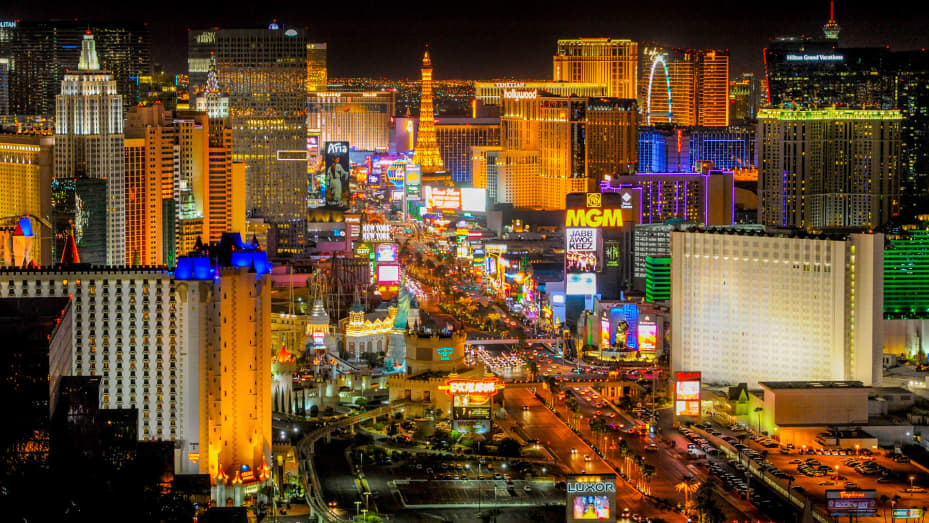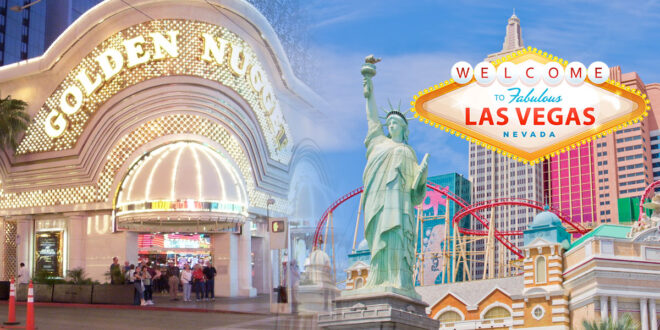Las Vegas is a city renowned for its grandeur, glamour, and the unbridled energy of its nightlife. For over a century it has been a mecca for those seeking pleasure and adventure on an epic scale. But long before the opulent casinos and neon lights of Sin City took center stage, there was another side to Las Vegas: one that had shaped the history of this city since its early days in the desert. This article will explore how the casino industry shaped Las Vegas from humble beginnings to becoming one of Americas most iconic cities. Well look at how gambling became legalized in Nevada, paving way for Las Vegas growth into an entertainment destination; well examine how high rollers helped bring more glamour to The Strip; and finally, well explore how technology has revolutionized modern day casinos throughout Nevada. So join us as we uncover The History of Las Vegas – How The Casino Industry Shaped The City!
Early Settlement of Las Vegas
 Las Vegas has a long and storied history that dates back to the mid-1800s, when Mormon settlers first arrived in the area. These early settlers were drawn by its remoteness, as well as its potential for economic opportunity. They set up farms and ranches on Las Vegas fertile land and began trading with other communities in Utah and California. The railroad brought more development to the area in 1905, connecting it to larger population centers like Los Angeles. This sparked an influx of new people into the region, which was further complimented by prohibition laws enacted across America during this time period. It wasnt until 1931 that Las Vegas truly began its transformation into what we know today—a vibrant city filled with casinos, resorts, entertainment venues, and more. By this time organized crime had become entrenched within the citys growing gambling industry; large sums of money were flowing through illegal activities such as bookmaking operations and slot machines while corrupt public officials facilitated their expansion under dubious pretenses. As these illicit businesses flourished throughout Nevada during this era so did Las Vegas itself—from a sleepy desert outpost to a bustling metropolis where anything seemed possible for those willing to risk it all at one of its many casino tables or slot machines
Las Vegas has a long and storied history that dates back to the mid-1800s, when Mormon settlers first arrived in the area. These early settlers were drawn by its remoteness, as well as its potential for economic opportunity. They set up farms and ranches on Las Vegas fertile land and began trading with other communities in Utah and California. The railroad brought more development to the area in 1905, connecting it to larger population centers like Los Angeles. This sparked an influx of new people into the region, which was further complimented by prohibition laws enacted across America during this time period. It wasnt until 1931 that Las Vegas truly began its transformation into what we know today—a vibrant city filled with casinos, resorts, entertainment venues, and more. By this time organized crime had become entrenched within the citys growing gambling industry; large sums of money were flowing through illegal activities such as bookmaking operations and slot machines while corrupt public officials facilitated their expansion under dubious pretenses. As these illicit businesses flourished throughout Nevada during this era so did Las Vegas itself—from a sleepy desert outpost to a bustling metropolis where anything seemed possible for those willing to risk it all at one of its many casino tables or slot machines
Emergence of the Casino Industry
 The emergence of the casino industry in Las Vegas was a pivotal moment for both the city and its citizens. It marked the beginning of a new era, one that would shape Las Vegas into what it is today; an entertainment capital of the world. The first casinos opened their doors in 1931 and by 1942, over thirty establishments had been granted gambling licenses from Clark County. This influx of casinos sparked tremendous economic growth—employment opportunities increased, tax revenues rose significantly and tourism was at an all-time high. Coupled with this massive surge in employment came job security: while many industries were hit hard by recessions during this period, casinos provided steady income to those who worked there due to their popularity with tourists. This newfound sense of stability allowed people to invest more heavily in local businesses and organizations, further driving up economic growth throughout the city. With such rapid expansion came some concerns about safety and regulation. Nevada passed several laws regulating gaming operations which included licensing requirements for operators as well as measures ensuring fairness within games offered at these establishments. These regulations helped ensure that visitors could trust they were playing on fair grounds while keeping crime levels reasonably low across Las Vegas’s developing casino industry – something that still stands true today!
The emergence of the casino industry in Las Vegas was a pivotal moment for both the city and its citizens. It marked the beginning of a new era, one that would shape Las Vegas into what it is today; an entertainment capital of the world. The first casinos opened their doors in 1931 and by 1942, over thirty establishments had been granted gambling licenses from Clark County. This influx of casinos sparked tremendous economic growth—employment opportunities increased, tax revenues rose significantly and tourism was at an all-time high. Coupled with this massive surge in employment came job security: while many industries were hit hard by recessions during this period, casinos provided steady income to those who worked there due to their popularity with tourists. This newfound sense of stability allowed people to invest more heavily in local businesses and organizations, further driving up economic growth throughout the city. With such rapid expansion came some concerns about safety and regulation. Nevada passed several laws regulating gaming operations which included licensing requirements for operators as well as measures ensuring fairness within games offered at these establishments. These regulations helped ensure that visitors could trust they were playing on fair grounds while keeping crime levels reasonably low across Las Vegas’s developing casino industry – something that still stands true today!
Expansion and Growth of Casinos in Las Vegas
 The casino industry in Las Vegas has been a major factor in the city’s expansion and growth over the past century. When early settlers first moved to the area, they found a small desert town with few amenities. However, gambling soon became legal in Nevada and as more casinos opened throughout the 20th century, Las Vegas began its transformation into an international tourist destination. From grand resorts on The Strip to iconic landmarks such as Caesars Palace, these casinos have become synonymous with Sin City and helped put it on the map worldwide. Furthermore, this influx of tourists has triggered a chain reaction of economic activity across many industries that further accelerated development in Las Vegas. As technology continues to evolve and new regulations are passed by state governments, we can expect even greater growth for this vibrant tourism hub as it continues to bring people together from all walks of life.
The casino industry in Las Vegas has been a major factor in the city’s expansion and growth over the past century. When early settlers first moved to the area, they found a small desert town with few amenities. However, gambling soon became legal in Nevada and as more casinos opened throughout the 20th century, Las Vegas began its transformation into an international tourist destination. From grand resorts on The Strip to iconic landmarks such as Caesars Palace, these casinos have become synonymous with Sin City and helped put it on the map worldwide. Furthermore, this influx of tourists has triggered a chain reaction of economic activity across many industries that further accelerated development in Las Vegas. As technology continues to evolve and new regulations are passed by state governments, we can expect even greater growth for this vibrant tourism hub as it continues to bring people together from all walks of life.
Conclusion
 Las Vegas is a city that has been shaped by its Casino industry for decades. From its beginnings as a small railroad town to the entertainment mecca it is today, Las Vegas has experienced an incredible transformation over the years. The casino industry helped fuel this growth, bringing in millions of tourists every year who come to enjoy the gaming opportunities available and play real money pokies. This influx of people has had a lasting effect on Las Vegas; creating jobs, boosting tourism revenue, and making it one of the most popular tourist destinations in America. The history of Las Vegas shows just how important casinos have been to its success story; transforming what was once a small desert community into an internationally recognized destination with attractions that appeal to all types of visitors from around the world.
Las Vegas is a city that has been shaped by its Casino industry for decades. From its beginnings as a small railroad town to the entertainment mecca it is today, Las Vegas has experienced an incredible transformation over the years. The casino industry helped fuel this growth, bringing in millions of tourists every year who come to enjoy the gaming opportunities available and play real money pokies. This influx of people has had a lasting effect on Las Vegas; creating jobs, boosting tourism revenue, and making it one of the most popular tourist destinations in America. The history of Las Vegas shows just how important casinos have been to its success story; transforming what was once a small desert community into an internationally recognized destination with attractions that appeal to all types of visitors from around the world.
 HQ Grande Prairie HQ Grandie Prairie is an online news portal aimed at providing latest day to day happenings of the World to its viewers.
HQ Grande Prairie HQ Grandie Prairie is an online news portal aimed at providing latest day to day happenings of the World to its viewers.

